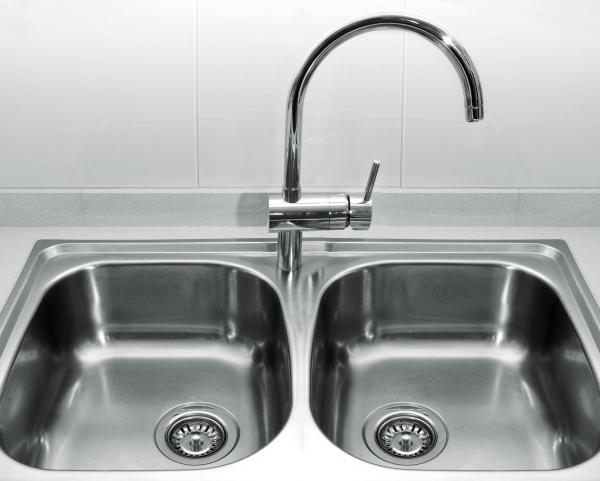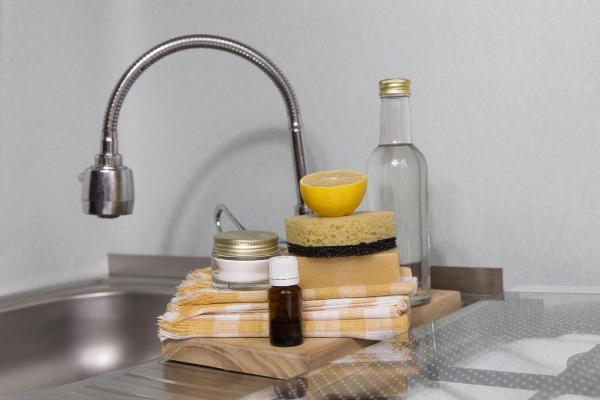
Even if it does not look like it, the sink is a real breeding ground for germs and bacteria. The sink is used several times a day, so it gets dirty easily. However, deep cleaning and removing odors from the sink is easier than you think. There are numerous special products on the market, but we can also apply natural remedies to make your sink look like new.
The following oneHOWTO article explains in detail how to clean a stainless steel sink to make it look like new.
Baking soda
Baking soda is an everyday product that can be found in every household. Although it is primarily used medicinally to treat digestive ailments such as heartburn, it is also an excellent natural cleaning and bleaching agent. Its granular nature makes it the perfect ally when it comes to decalcifying any surface and destroying adhering dirt, including stainless steel, which is not affected by its action.
In order to use this agent, you must first remove all the dishes from the sink and perform a superficial cleaning with water and dishwashing detergent.
If you have used a scourer that does not scratch and have rinsed the entire surface of the sink well, including the faucet and drain, sprinkle it with baking soda. Spread a slightly larger amount on the areas where you see stains or encrusted dirt.
Let it sit for a few minutes, then take a soft sponge or scouring pad, wet it under the tap and wipe it all over the inside of the sink. Finally, remove the baking soda with plenty of warm water and dry with a microfiber towel.
You may be interested in this other article, where we explain how to use baking soda to clean silver items.
Vinegar and lemon
White vinegar or apple cider vinegar and lemon juice make a perfect tandem when it comes to cleaning a stainless steel sink. It not only disinfects it, but also gives it an extra shine. It is an effective remedy for accumulated dirt, which is also recommended for regular cleaning to keep the sink in optimal condition without much effort.
If your sink has a patina that reduces its shine, especially around the drain, vinegar, and lemon are the best cleaners. As in the previous case, first clean the sink with hand dishwashing detergent and rinse with water.
Then, soak a sponge in a solution consisting of the same amount of water as white vinegar and an additional squeeze of lemon juice.
Run the sponge over the entire surface and let it sit for 10-15 minutes. Re-moisten the sponge and rub it over the surface, but without pressing too hard so as not to cause scratches. Finally, rinse with plenty of water.
Did you know that vinegar has countless uses in the home? You may also be interested in this other article where we explain all the amazing uses of vinegar in the home.

Potatoes
To remove stubborn stains without damaging the surface of the stainless steel sink and keep it ultra-shiny, you can resort to a simple, effective and also inexpensive trick.
Clean the entire sink with a damp sponge and a few drops of soap, and rinse it with hot water. Also, take a large potato and cut it in half (you do not have to remove the skin). Brush one half over the entire surface of the stainless steel. Let the potato sit for a few minutes and then rinse it off with plenty of hot water. To finish cleaning, take a cloth, preferably microfiber, and gently rub the sink while you dry it.
Potatoes are not just for cleaning your sink. Potatoes contain a number of vitamins, minerals, and enzymes that not only reduce bags under the eyes, but also rejuvenate the skin around the eyes, keeping it firm and radiant. Learn how to reduce bags under your eyes with potatoes.
Flour
Aside from its usual uses in the kitchen, flour can also be used to clean the grooves and folds of the drains, sinks, and faucets in your bathroom.
Wash the sink with a scouring pad, soap and water, removing any small bits of food that may have been left behind. Dry it with a cloth and then sprinkle flour all over the surface. You do not need to apply a large amount. A thin layer on the stainless steel is sufficient.
Then, using a dry microfiber cloth, rub the entire surface with circular motions over the flour, without applying too much pressure. Finally, remove the flour with the same cloth, without using water. Only when you have removed everything, open the faucet and let the water run for a few minutes. The flour will absorb any dirt and especially grease, making your sink look like new again.
Sometimes the reason your sink loses its luster so quickly is because of hard water. Water is 'hard' when it contains a high level of dissolved minerals. When this water evaporates, it leaves behind some mineral deposits on the surfaces called hard rock.

If you want to read similar articles to How to Clean a Stainless Steel Sink, we recommend you visit our Home cleaning category.